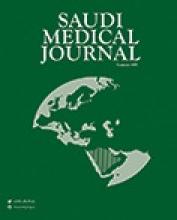Abstract
OBJECTIVE: To determine epidemiological characteristics of imported malaria infections in Riyadh, Kingdom of Saudi Arabia, based on retrospective analysis of laboratory records within the Central Laboratory.
METHODS: Records of the Malaria Referral Laboratory in Riyadh, Kingdom of Saudi Arabia (KSA) were reviewed for the past 6 years: 1416-1421 Hejri inclusive (1996-2001 Gregorian). The dates of blood films were converted to Gregorian calendar in addition to the Hejri dates already used in the records. Data collected included the date of film, age, sex, nationality and parasitological findings in the film. All data was entered and analyzed using statistical package for social sciences computer software.
RESULTS: The annual mean number of positive slides was 212 +/- 78. Positive slides were reported at the rate of 18 /100,000 among 137,402 potential blood donors screened during this period. The overall slide positivity was 12.9% among suspected cases referred from hospitals and 9.5% among those referred from health centers and private clinics. Most positive slides were from Saudis (36.6%), Sudanese (30.9%), Indians (13.9%), Pakistanis (8%) and Yemenis (5%). The type of malaria infection varied in the different nationalities, reflecting the pattern of endemicity at the source of infection. Positive cases show a marked seasonality in Saudis, reflection seasonal transmission of the disease in the endemic areas.
CONCLUSION: Although there is no active malaria transmission in Riyadh KSA, imported infections still poses a significant health problem. A high index of suspicion should be maintained in those with suggestive travel history. Efforts to reduce the incidence of transfusion malaria should aim at formulation of appropriate policies for selection of blood donors and for screening of blood.
- Copyright: © Saudi Medical Journal
This is an open-access article distributed under the terms of the Creative Commons Attribution-Noncommercial-Share Alike 3.0 Unported, which permits unrestricted use, distribution, and reproduction in any medium, provided the original work is properly cited.






